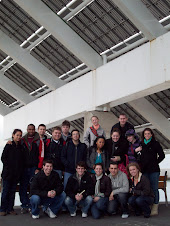After writing on the drought in Catalonia, I was blessed with a day of rain! Barcelona is a beautiful Mediterranean city in the municipality of Catalonia. Although the weather is temperate all year round, lately there has been a lack of precipitation causing worry among the people.
Sitting in studio working on our project, the day dreary and gray, we were surprised to hear the rain. It's rained on a few occasions- at night and for short bursts- throughout the entire time we've been here. The rhythmic noise of the rain hitting the surfaces of the city is refreshing and welcoming, increasingly so because of the drought. The peaceful sound fills the city, rejuvenating it physically and psychologically.
This impact on the urban scale is evanescent, the sound only last as long as the weather, but thats what's intriguing about sound. Specific sounds are never perpetual, some are reoccurring though. The noises that are reoccurring trigger memories and associations, while newer sounds trigger curiosity at the source. Both types, reoccurring and newly occurring, can be (and are) used to impact the perception of a space. Water is added to spaces to tangibly refresh and cool, but the sound of water is just as important. Water fountains that create the trickling noise from their flowing water are advertised as "calming" and "refreshing." The sound of the water is what brings about these feelings. On an urban scale, water features (like the linear path of flowing and cascading water from Joan Miro to near the MNAC) fill the garden space with a memory of refreshment as well as the tangible. Materiality within buildings effects the soundscape as well. Tin roofs ping with the impact of rain, while tiles absorb more of the sound.
As kitschy as it may be, when I'm inside and I close my eyes to the sound of rain, I can feel the wet drops, drawing from previous experience. Eric reminds us that any writer can describe rain as wet, but only a good writer can make the reader feel the wetness of rain. I'm not a prolific writer, but I'm becoming a better designer.
Sitting in studio working on our project, the day dreary and gray, we were surprised to hear the rain. It's rained on a few occasions- at night and for short bursts- throughout the entire time we've been here. The rhythmic noise of the rain hitting the surfaces of the city is refreshing and welcoming, increasingly so because of the drought. The peaceful sound fills the city, rejuvenating it physically and psychologically.
This impact on the urban scale is evanescent, the sound only last as long as the weather, but thats what's intriguing about sound. Specific sounds are never perpetual, some are reoccurring though. The noises that are reoccurring trigger memories and associations, while newer sounds trigger curiosity at the source. Both types, reoccurring and newly occurring, can be (and are) used to impact the perception of a space. Water is added to spaces to tangibly refresh and cool, but the sound of water is just as important. Water fountains that create the trickling noise from their flowing water are advertised as "calming" and "refreshing." The sound of the water is what brings about these feelings. On an urban scale, water features (like the linear path of flowing and cascading water from Joan Miro to near the MNAC) fill the garden space with a memory of refreshment as well as the tangible. Materiality within buildings effects the soundscape as well. Tin roofs ping with the impact of rain, while tiles absorb more of the sound.
As kitschy as it may be, when I'm inside and I close my eyes to the sound of rain, I can feel the wet drops, drawing from previous experience. Eric reminds us that any writer can describe rain as wet, but only a good writer can make the reader feel the wetness of rain. I'm not a prolific writer, but I'm becoming a better designer.























